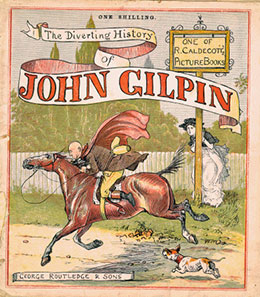 It is almost guaranteed that children will respond favorably to animal stories, especially stories with dogs and cats. Two-thirds of American households own dogs or cats. Nineteenth century British illustrator Randolph Caldecott seemed to understand the natural affinity between children and animals. Before science documented the importance of pets in children’s lives, he included animals in most of his illustrations, and they added to the frolicking fun that animated his scenes.
It is almost guaranteed that children will respond favorably to animal stories, especially stories with dogs and cats. Two-thirds of American households own dogs or cats. Nineteenth century British illustrator Randolph Caldecott seemed to understand the natural affinity between children and animals. Before science documented the importance of pets in children’s lives, he included animals in most of his illustrations, and they added to the frolicking fun that animated his scenes.
Many Caldecott Award illustrators also include animals in their artwork, particularly dogs and cats. They are main characters, supporting cast members, or sometimes just included in a scene. Several are based on real animals the illustrators have known. Sharing anecdotes and interesting facts about the real dogs and cats of Caldecott Award books make the illustrators come alive for children. They add both “human interest” and “animal interest.”
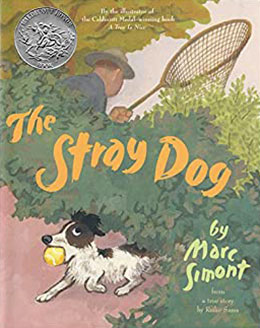 True stories have a special appeal to children. After hearing or reading a story, they frequently ask, “Did that really happen?” Marc Simont relates a heartwarming true story about how his friend Reiko Sassa’s family adopted Willy in The Stray Dog, a 2002 Caldecott Honor book. While on a family picnic, a boy and girl play with a scruffy little dog in the park. They name him Willy but must part with him when the family returns home because “He must belong to somebody…and they would miss him.” Each family member worries about Willy throughout the week. They return to the park the following Saturday hoping to see him. And, they do, only Willy doesn’t stop to visit. He races by with the dog warden in close pursuit. With Willy cowering beneath his net, the warden informs the children, “He has no collar. He has no leash…This dog is a stray. He doesn’t belong to anybody.” The boy removes his belt and the girl removes her hair ribbon. “Here’s his collar…Here’s his leash…His name is Willy, and he belongs to us.” With simple watercolors, Simont shows Willy’s curiosity, playfulness, terror, hope, and joy.
True stories have a special appeal to children. After hearing or reading a story, they frequently ask, “Did that really happen?” Marc Simont relates a heartwarming true story about how his friend Reiko Sassa’s family adopted Willy in The Stray Dog, a 2002 Caldecott Honor book. While on a family picnic, a boy and girl play with a scruffy little dog in the park. They name him Willy but must part with him when the family returns home because “He must belong to somebody…and they would miss him.” Each family member worries about Willy throughout the week. They return to the park the following Saturday hoping to see him. And, they do, only Willy doesn’t stop to visit. He races by with the dog warden in close pursuit. With Willy cowering beneath his net, the warden informs the children, “He has no collar. He has no leash…This dog is a stray. He doesn’t belong to anybody.” The boy removes his belt and the girl removes her hair ribbon. “Here’s his collar…Here’s his leash…His name is Willy, and he belongs to us.” With simple watercolors, Simont shows Willy’s curiosity, playfulness, terror, hope, and joy.
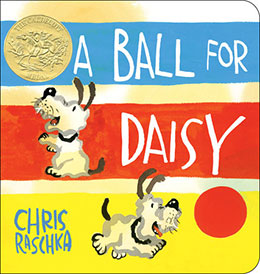 Chris Raschka also uses watercolors to depict a range of emotions in Daisy after she loses her most prized possession when another dog pops her ball in the park. In A Ball for Daisy, the wordless 2013 Caldecott Medal book, Raschka’s gestural art deftly captures Daisy’s bewilderment, anger, dejection, and sorrow. Though not exactly a true story, it is based on a true incident that happened to Raschka’s son Ingo. When Ingo was four years old, a neighbor’s dog named Daisy took his yellow ball, bit down too hard on it, and broke it. This Daisy was a large black dog, not the Daisy of the book. But his son experienced emotions of disbelief, devastation, and irrevocable loss similar to Daisy. In his Caldecott Medal acceptance speech, Raschka said, “The task of a picture book illustrator, I would say, is to remember a particular emotion, heighten it, and then capture it in some painted vocabulary, so that the same emotion is evoked in the child, in the reader.” Both he and Marc Simont do this eloquently with what appear to be effortless brush strokes.
Chris Raschka also uses watercolors to depict a range of emotions in Daisy after she loses her most prized possession when another dog pops her ball in the park. In A Ball for Daisy, the wordless 2013 Caldecott Medal book, Raschka’s gestural art deftly captures Daisy’s bewilderment, anger, dejection, and sorrow. Though not exactly a true story, it is based on a true incident that happened to Raschka’s son Ingo. When Ingo was four years old, a neighbor’s dog named Daisy took his yellow ball, bit down too hard on it, and broke it. This Daisy was a large black dog, not the Daisy of the book. But his son experienced emotions of disbelief, devastation, and irrevocable loss similar to Daisy. In his Caldecott Medal acceptance speech, Raschka said, “The task of a picture book illustrator, I would say, is to remember a particular emotion, heighten it, and then capture it in some painted vocabulary, so that the same emotion is evoked in the child, in the reader.” Both he and Marc Simont do this eloquently with what appear to be effortless brush strokes.
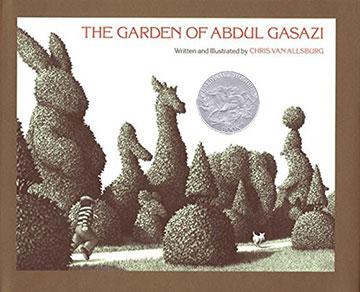 Chris Van Allsburg writes and illustrates a story about a real dog, although the story is not true. He introduces Fritz in his first book The Garden of Abdul Gasazi that won a Caldecott Honor in 1980. Fritz is Miss Hester’s mischievous dog who leads Alan on a wild chase through a mysterious magician’s garden. Van Allsburg envisioned Fritz to be a bull terrier. When his brother-in-law told him that he was going to purchase a dog, Van Allsburg convinced him to buy a bull terrier, and he used his brother-in-law’s dog Winston as the model for Fritz. Unfortunately, the dog was hit by a car and died. To honor the contribution of Winston to his first book, Van Allsburg gives him cameo appearances his other books, two of which won Caldecott Medals. Done in pencil in the same surrealistic style, Fritz is a pull toy in Jumanji, the 1982 Caldecott Medal winner. Switching to dreamy watercolors in the 1986 Caldecott Medal book The Polar Express, Fritz is the hand puppet on the bedpost in the little boy’s room.
Chris Van Allsburg writes and illustrates a story about a real dog, although the story is not true. He introduces Fritz in his first book The Garden of Abdul Gasazi that won a Caldecott Honor in 1980. Fritz is Miss Hester’s mischievous dog who leads Alan on a wild chase through a mysterious magician’s garden. Van Allsburg envisioned Fritz to be a bull terrier. When his brother-in-law told him that he was going to purchase a dog, Van Allsburg convinced him to buy a bull terrier, and he used his brother-in-law’s dog Winston as the model for Fritz. Unfortunately, the dog was hit by a car and died. To honor the contribution of Winston to his first book, Van Allsburg gives him cameo appearances his other books, two of which won Caldecott Medals. Done in pencil in the same surrealistic style, Fritz is a pull toy in Jumanji, the 1982 Caldecott Medal winner. Switching to dreamy watercolors in the 1986 Caldecott Medal book The Polar Express, Fritz is the hand puppet on the bedpost in the little boy’s room.
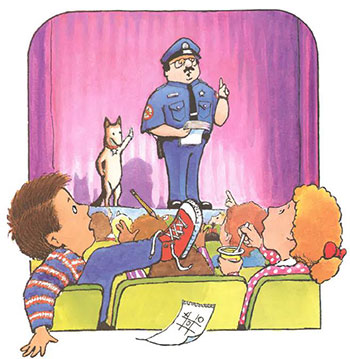
Gloria is the canine celebrity of Officer Buckle and Gloria, the 1996 Caldecott Medal winner. Unbeknownst to her partner Office Buckle, Gloria mimes his safety tips behind his back when he addresses school audiences. The students roar their approval, and Officer Buckle thinks the applause is for him. He doesn’t discover he’s been upstaged until he sees his speech televised on the 10:00 o’clock news. On her website, the author/illustrator Peggy Rathmann reveals that her family dog, who did naughty things when no one was watching, was an influence on her writing. She relates the story of the time her mother was being videotaped in the dining room, and the dog was licking all the poached eggs on the buffet behind her. Neither her mother nor the person behind the camera noticed. Filming continued while the family ate breakfast and commented on the delicious eggs. Rathmann writes, “The first time we watched that tape we were so shocked, we couldn’t stop laughing.” Rathmann’s use of bright watercolors and cartoon style fits the humorous mood of this story.
Just as authors often write about what they know, illustrators often draw what they know, and sometimes they include their own pets in their illustrations. Beth Krommes included many of her favorite things in her 2009 Caldecott Medal book The House in the Night written by Susan Marie Swanson. She sets the story in the rolling countryside of Pennsylvania where she grew up. In the story, Krommes incorporates her young self as the child and the family pet Scamp as the dog. In the first illustration of the story, the dog is featured prominently. Very faintly, the name Scamp is scratched on his dog tag. The black and white scratchboard technique Krommes employs uniquely depicts nighttime darkness and allows for warm golden yellow highlights.
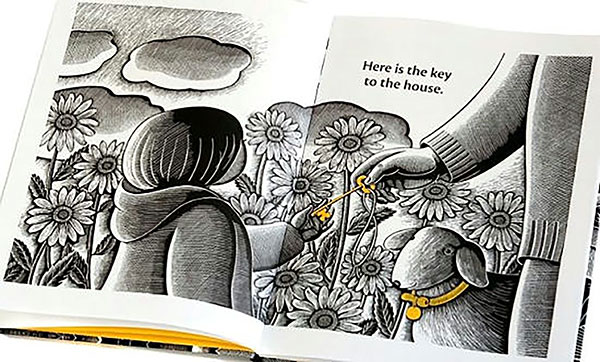
Maurice Sendak and David Shannon also included their own dogs in books. Sendak had a Sealyham terrier named Jennie who is the worried dog Max chases while brandishing a fork in Where the Wild Things Are, winner of the 1964 Caldecott Medal. Jennie is featured in her own book Higgledy Piggledy Pop! Or There Must Be More to Life in which she becomes the leading lady of the World Mother Goose Theatre. The book was written in 1967 as a tribute to Jennie after she died, and though it did not win a Caldecott Award, it was made into a movie.
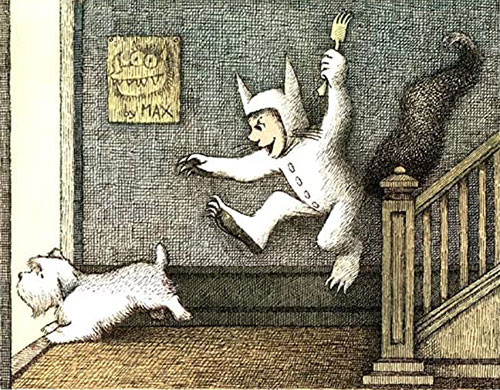
David Shannon also immortalized his dog, a West Highland terrier named Fergus, in his book Good Boy, Fergus! Though not a major character in the 1999 Caldecott Honor book No, David!, Fergus can be spotted watching David in the illustration in which the little boy runs naked down the street. Fergus also appears in other David books. Both Sendak and Shannon draw in cartoon style, but the breeds of their dogs are clearly discernable.
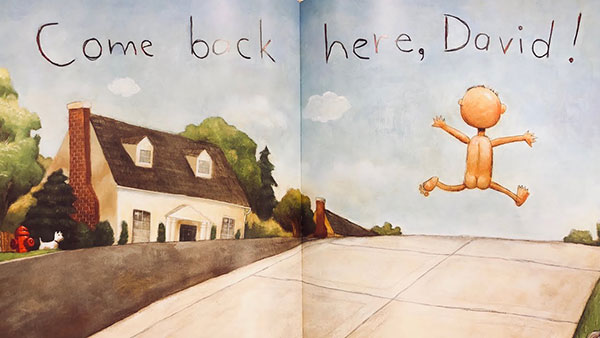
Picture Books Cited
Raschka, C. (2001). A Ball for Daisy. New York: Schwartz & Wade.
Rathmann, P. (1995) Office Buckle and Gloria. New York: Putnam.
Simont, M. (2001). The Stray Dog: From a True story by Reiko Sassa. New York: HarperCollins.
Sendak, M. (1963). Where the Wild Things Are. New York: Harper and Row.
Sendak, M. (1967). Higgledy Piggledy Pop! Or there must be more to life. New York: HarperCollins.
Shannon, D. (1998). No, David! New York: Blue Sky.
Shannon, D. (2006). Good Boy, Fergus! New York: Blue Sky.
Swanson, S. M. & Krommes, B. (2008). The House in the Night. Boston: Houghton Mifflin Harcourt.
Van Allsburg, C. (1979). The Garden of Abdul Gasazi. Boston: Houghton Mifflin.
Van Allsburg, C. (1981). Jumanji. Boston: Houghton Mifflin.
Van Allsburg, C. (1985). The Polar Express. Boston: Houghton Mifflin.
References
Krommes, B. (2009). Caldecott Medal acceptance speech: On “pow” moments and getting “The Call.” Children and Libraries, 7, (2), 11 – 13.
Lanes, S. G. (1990). The Art of Maurice Sendak. New York: Abrams.
Rathmann, P. (2013). Books by: Peggy Rathmann — official site: About the author.
Raschka, C. (2012). Caldecott Medal acceptance. Horn Book Magazine, 88, (4), 17 – 25.
Severson, R. L. (2014). The value of (research on) animals in children’s lives. Human Development, 57: 26 – 29. .
Shannon, D. (2015). David Shannon’s website: FAQ.
Susina, J. (2001). [Review of the book The stray dog by Marc Simont]. The Five Owls, 15, (5).
Van Allsburg, C. (2015). FAQs.

Love this new column already!
Thank you, Gail and Heidi! My brain hears the words in picture books, picking them apart, enjoying how they play in my brain. “Seeing” has always been secondary to my experience. I love this guided trip, and very much look forward to more!